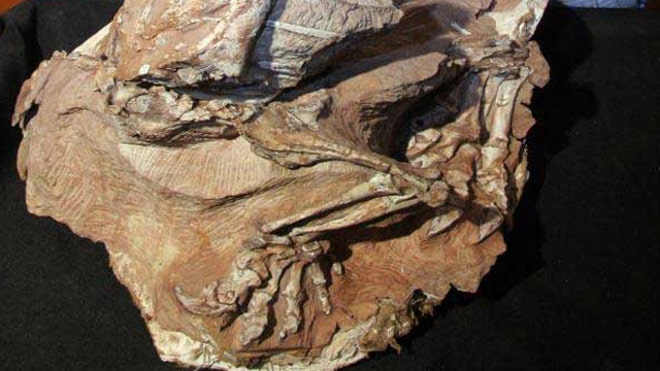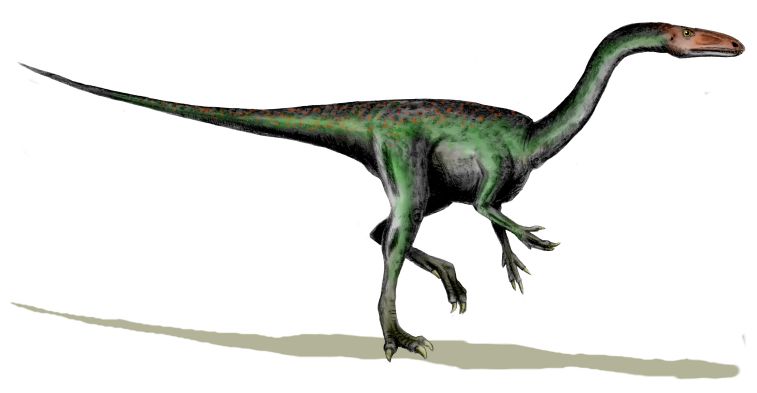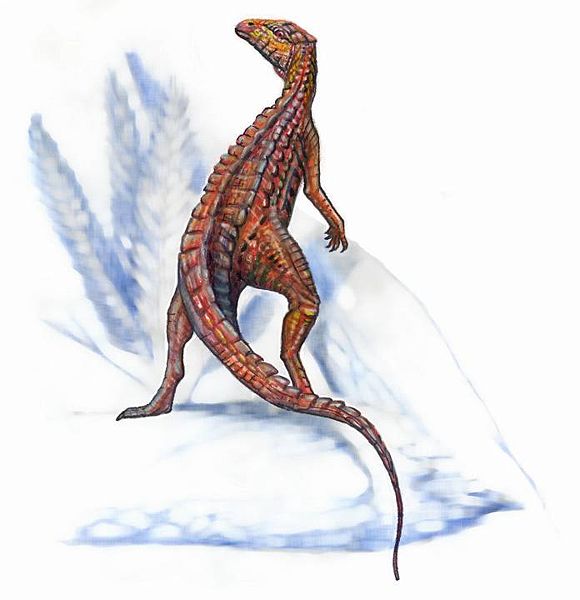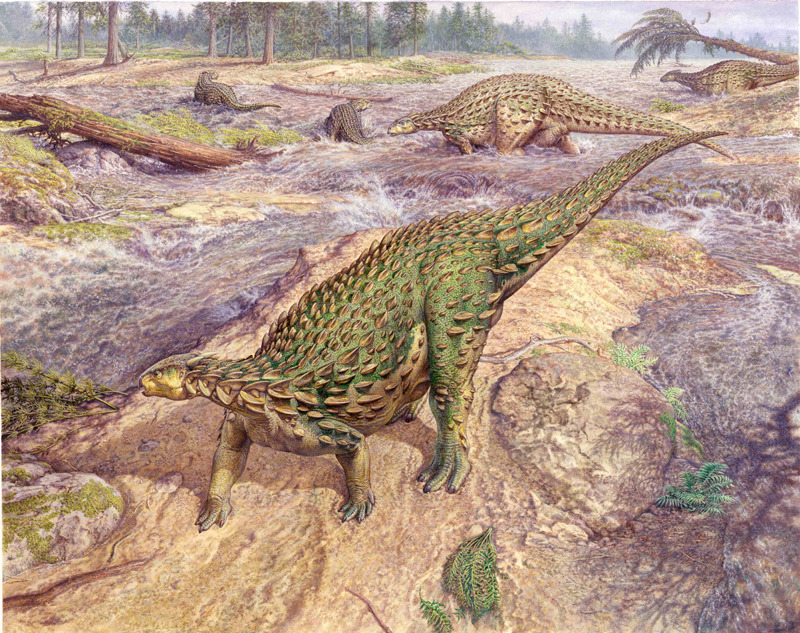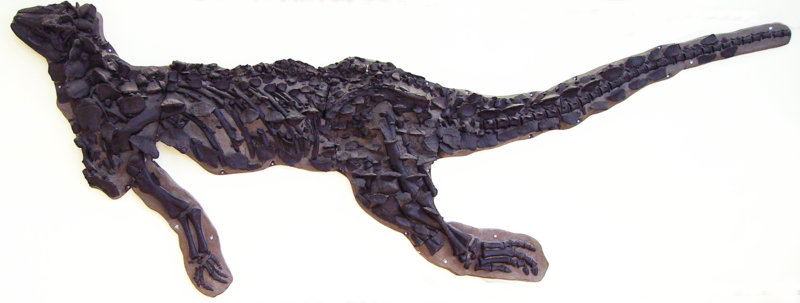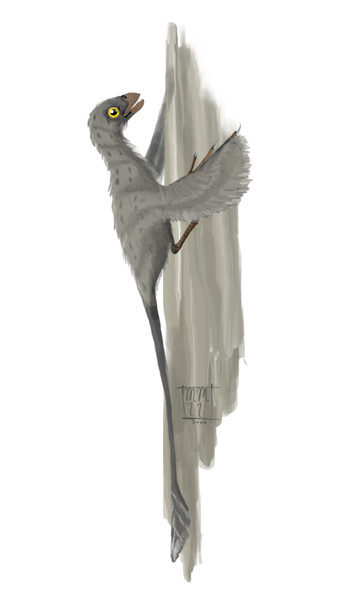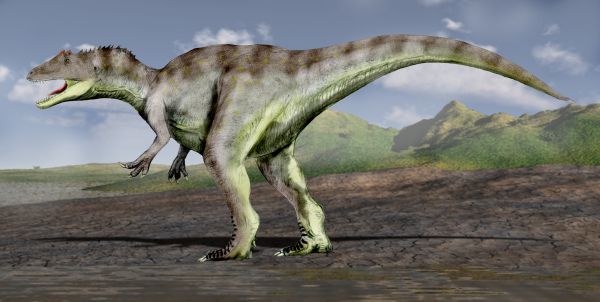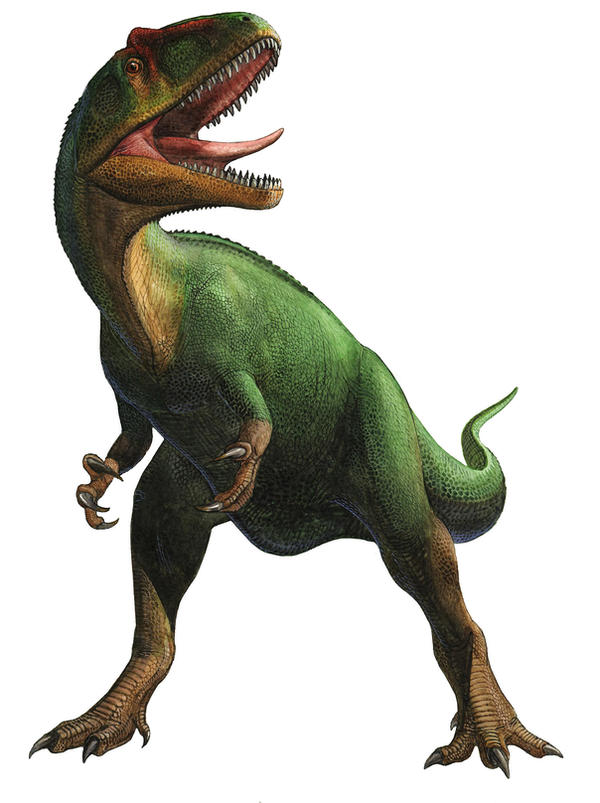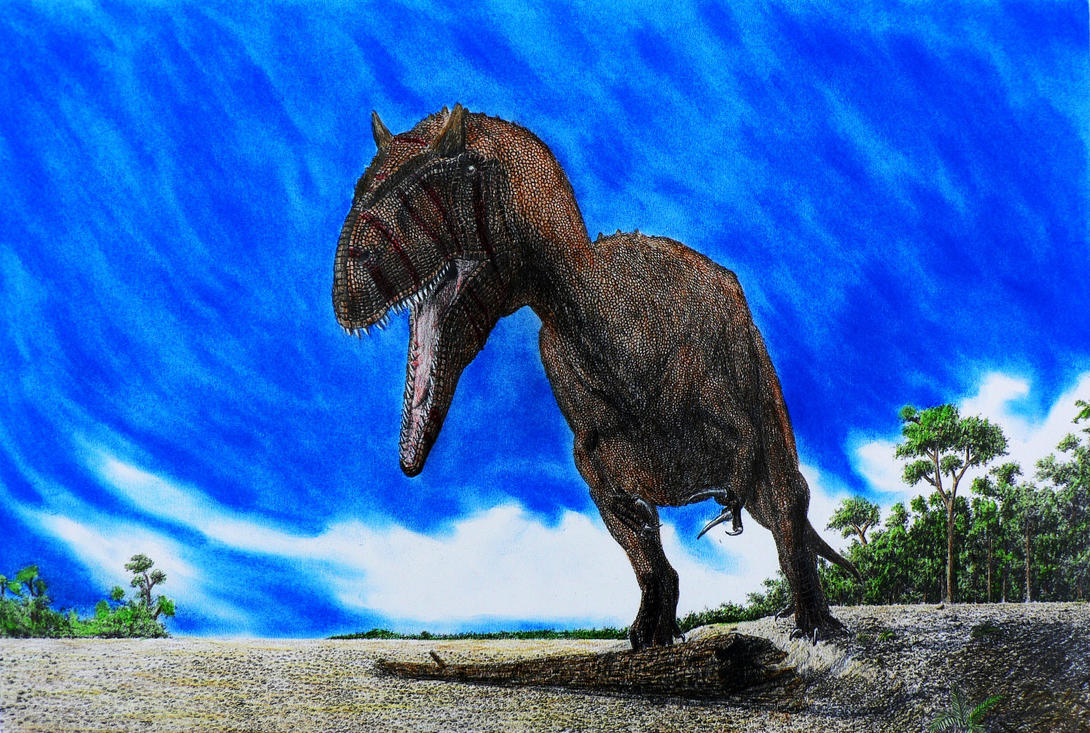[Recent Entries][Archive][Friends][User Info]
Below are 20 entries, after skipping 20 most recent ones in the "Сообщество, посвящённое ра" journal:[<< Previous 20 entries -- Next 20 entries >>]
| January 24th, 2013 | |
|---|---|
| 07:47 pm [industrialterro] [Link] |
Xiaosaurus Xiaosaurus dashanpensis — вид травоядных птицетазовых динозавров, живших в середине юрского периода (между 171,6—161,2 млн лет) в районе современного Китая. Был небольшим двуногим динозавром, с длиной около одного метра. Описан в 1983 году. Голотип, IVPP V6730A, был найден в формации Xiashaximiao, чей возраст является неопределенным: разными исследователями относится к байоцинскому или калловскому веку. Голотип состоит из частичного скелета с фрагментом челюстной кости, двух шейных позвонков, четырех хвостовых позвонков, плечевой кости, части левого бедра и полной правой задней конечности. Второй скелет, IVPP V6730B, обозначен как паратип. Он включает в себя правую бедренную кость, несколько грудных позвонков, два крестцовых позвонка, фаланги пальцев, ребра и два зуба. Точное кладистическое положение данного динозавра является неопределенным, и он помечен как nomen dubium. Баррет в 2005 году отнес его в группу птицетазовых динозавров с пометкой incertae sedis. In 1979 and 1980 two specimens of a small herbivorous dinosaur were discovered during excavations near Dashanpu in Sichuan. In 1983 Dong Zhiming and Tang Zilu named the fossils under the type species Xiaosaurus dashanpensis. The generic name is derived from Chinese xiáo, 曉, "dawn", a reference to the age of the fossil. The specific name refers to Danshanpu. In 1992 Peng Guangzhao renamed Agilisaurus multidens He & Cai 1983 (now Hexinlusaurus) into a second species of Xiaosaurus: Xiaosaurus multidens, but this has not been accepted. Xiaosaurus was a small bipedal animal with an estimated length of one metre. The femur is 11 centimetres (4.3 in) long. The remains are too fragmentary to easily classify the genus. The describers assigned it both to the Fabrosauridae and the Hypsilophodontidae, considering it an evolutionary link between Lesothosaurus and Hypsilophodon. Xiaosaurus has sometimes been considered a nomen dubium and an ornithischian of uncertain affinities, possibly a basal cerapod or marginocephalian. However, Paul Barrett et al. in 2005 concluded it to be provisionally valid, as it possessed a single unique derived trait or autapomorphy: a mediolaterally (seen from the front) straight humerus
Tags: Вымершие рептилии, Юра, авеметатарзалии, архозавроморфы, архозавры, диапсиды, динозавроморфы, динозавры, неорнитискии, птицетазовые |
| 07:09 pm [industrialterro] [Link] |
Vulcanodon Вулканодон (Vulcanodon — «зуб вулкана») — вымерший род динозавров, инфраотряда зауроподов. Вулканодон обладал небольшими размерами, в длину он составлял 6,5 метров, а в высоту был чуть больше человека, около 1,9 метра. Вес его был около 750 килограммов. Обладал длинными, относительно размеров тела, шеей и хвостом. На лапах вулканодона были острые когти, служившие хорошей защитой от атак хищников. Считается, что вулканодоны вели стадный образ жизни. Статус вулканодона, как завропода был установлен в 1975 году на основе формы костей пальцев. Они больше по ширине, чем по высоте, что является характерной чертой завропода, - хотя в данном случае они даже шире, чем у обычных завропод. Кроме того, передние ноги вулканодона длиннее, чем у других завропод. В целом, этот вид имеет строение тела, характерное как для завропод, так и для динозавров из более архаичной группы - прозавропод. В частности строение кости бедра говорит о близости к последним. Помимо этого у вулканодона имелось очень много примитивных черт в строении костей таза, позвонков и конечностей. Возможно, вулканодоны были переходным звеном в эволюции динозавров. Вулканодон был представителем травоядных ящеров осноным рационом которых были листья, трава и другая растительность, которую он заглатывал целиком, так как его зубы не были приспособлены для пережевывания пищи (вместо них с этой задачей справлялись камни-гастролиты, которые эти ящеры регулярно заглатывали). Вулканодон обитал на территории современной Южной Африки (Зимбабве), около 208—201 млн лет назад (Ранняя Юра). Вулканодона описал палеонтолог Майкл Раат из Университета Витватерсранда в 1972 году. Сначала вулканодон был отнесен к группе всеядных прозауроподов, из-за формы зуба, найденного на раскопках. Позже было установлено, что данный зуб принадлежал другому ящеру, который возможно обгладывал тушу вулканодона, после чего Майкл Раат исправил свою же ошибку в описании этого вида. Ошибку он совершил по причине отсутствия головы и шеи у исследуемого скелета. Vulcanodon (meaning "volcano tooth") was a relatively small early sauropod dinosaur genus from the Early Jurassic of southern Africa. About 6.5 metres (20 ft) long, Vulcanodon was herbivorous and had unusually long bones of the first toe and large claws on the inside toes. The type species, V. karibaensis, was formally described by Michael A. Raath of the University of the Witwatersrand, Johannesburg, in 1972 based on fossils found in Rhodesia (now known as Zimbabwe). It was originally believed to be a prosauropod because of the knife-shaped teeth found near its fossils, which fit in with the idea that prosauropods were omnivorous. Scientists now know that the teeth belonged to an unidentified theropod that scavenged on the Vulcanodon's carcass. Vulcanodon is now known to be a true sauropod. The first fossils of Vulcanodon were found sandwiched between volcanic flows, giving it its name. Upon the discovery of the related Tazoudasaurus, both animals were unified in the family Vulcanodontidae. A skull of Vulcanodon has not yet been found, so it must be guessed at. As one of the earliest and basalmost sauropods, Vulcanodon helps to understand the early evolution of this group. Sauropods descend from basal sauropodomorphs (informally called "prosauropods"), which were primitively bipedal (two legged). While Vulcanodon already was fully quadrupedal, its limb proportions were intermediate between those of its prosauropod ancestors and those of later, more derived sauropods. Its limbs were sturdy and column like, and the forelimbs were already proportionally long, reaching 76 % of hindlimb length. Its lower leg, metatarsus, and toes were shortened in comparison to its bipedal ancestors, but still not as short as in later sauropods. The posture of the foot is unclear; it either was digitigrade as in "prosauropods" (only the digits touch the ground) or semiplantigrade as in later sauropods (both the digits and parts of the metatarsals touch the ground). The sacrum was made out four fused sacral vertebrae; "prosauropods" posessed only three sacrals. The pelvis, on the other hand, was relatively primitive, reminiscent of its prosauropod ancestors. Like in other sauropods, the hallux (the first toe of the foot) beared an enlarged claw. Uniquely, the claws of the second and third toe were nail-like and broader than deep, distinguishing Vulcanodon from all other known sauropods.
Размеры тела в сравнении с человеком:
Tags: Вымершие рептилии, Юра, авеметатарзалии, архозавроморфы, архозавры, вулканодонтиды, диапсиды, динозавроморфы, динозавры, завроподоморфы, завроподы, ящеротазовые |
| 06:11 pm [industrialterro] [Link] |
Tuojiangosaurus Туоджиэнгозавр (Tuojiangosaurus, кит. 沱江龙 (tuójiānglóng), дословно — «ящер с реки Туо») — род динозавров позднего Юрского периода с единственным видом — Tuojiangosaurus multispinus. Достигал длины в 7 метров, высоты в 2 метар и веса в более чем 4 тонны. На хвосте и плечах имел колючки. Физически идентичен североамериканскому стегозавру, вероятно, являясь его китайской разновидностью или популяцией. Обнаружен в провинции Сычуань, КНР. Скелеты выставлены в нескольких музеях, в том числе — в Лондоне. Этот динозавр, живший 157-154 млн. лет назад, был открыт в 1977 году. Внешне этот динозавр был очень похож на американского стегозавра: у него были маленькая голова, клюв, как у попугая, передние лапы были меньше задних, из-за чего спина была покатой, хвост был снабжён четырьмя большими шипами. Его спинные платины отличались по форме от аналогичных пластин стегозавра: они были больше похожи на большие плоские шипы, чем на стандартные пластины стегозаврид. Зубы маленькие, грубо зазубренные, с вертикальными бороздками. Туоджиэнгозавры жили небольшими группами, возле больших водоёмов, где в изобилии росли папоротники, которыми питались эти ящеры. Tuojiangosaurus (meaning "Tuo River lizard") is a genus of stegosaurid dinosaur from the Late Jurassic Period, recovered from the Upper Shaximiao Formation of what is now Sichuan Province in China. Physically similar to the North American Stegosaurus, Tuojiangosaurus is the best understood of the Chinese stegosaurids. It was around 7 metres (23 ft) long and 2 metres (6.6 ft) high, with a postulated weight of around 4 tonnes (4.4 short tons). The type and only species, T. multispinus, was named in 1977 (exactly a hundred years after Stegosaurus) on the strength of two specimens, one over half complete. Like Kentrosaurus, Tuojiangosaurus had two rows of pointed plates along the spine, which became taller over the hip region. It also had two outward-pointing spikes on each side of the end of the tail, angled at approximately 45 degrees to the vertical. In stegosaurids, this spike arrangement has become affectionately known as the "thagomizer". It also had the typical narrow head, bulky body, and low teeth of other stegosaurids. Because it lacked the tall spines for muscle attachment found on the vertebrae of Stegosaurus, it was probably unable to rear up on its hind legs like that animal. This suggests that it would have eaten low-lying, ground vegetation. A mounted skeleton of Tuojiangosaurus multispinus is on display at the Municipal Museum of Chongqing. In addition, a mounted cast is on display at the Natural History Museum, in London.
Репродукции (1, 2, 3, 4, 5, 6, 7, 8):
( Read More ) Размеры тела в сравнении с человеком:
Ископаемые останки и реплики (1, 2, 3, 4, 5, 6, 7, 8):
( Read More ) Tags: Вымершие рептилии, Юра, авеметатарзалии, архозавроморфы, архозавры, диапсиды, динозавроморфы, динозавры, птицетазовые, стегозавриды, стегозавры, тиреофоры |
| January 21st, 2013 | |
| 07:28 pm [industrialterro] [Link] |
Torvosaurus Торвозавр (Torvosaurus tanneri) – гигантский хищный динозавр позднеюрской эпохи. Относится к семейству Megalosauridae (часть Spinosauroidea), ближайший родственник знаменитого мегалозавра. Достигал 12 метров в длину и веса 5 тонн. Тело массивное, голова крупная (длина черепа больше 1,5 метра), передние конечности трехпалые, редуцированные. Ноги относительно короткие. Описан в 1979 году из позднеюрских (киммеридж) отложений формации Моррисон в Колорадо, найден также в Вайоминге и Юте. К этому же виду может относиться мегалозавр эдмарка (Edmarka rex) из поздней юры Вайоминга (из-за огромных размеров неофициально прозванный «Терминатором») и бронтораптор (Brontoraptor) из киммериджа Колорадо. В 2000 году остатки очень крупного (длина черепа около 1,58 м) торвозавра были найдены в позднеюрских отложениях Португалии. Таким образом, торвозавр был одним из самых крупных хищных динозавров юрского периода наряду с эпантериасом и заврофаганксом. В целом, останки мегалозавров в формации Моррисон встречаются гораздо реже, чем останки аллозавров и цератозавров. Можно предположить, что торвозавры не охотились стаями. Возможно, эти громадные хищники питались в основном падалью. Torvosaurus (pron.: /ˌtɔrvɵˈsɔrəs/) is a genus of large theropod dinosaur that lived during the Late Jurassic period (mid-late Kimmeridgian stage in North America, early Tithonian stage in Europe). The name Torvosaurus means "savage lizard" and is derived from the Latin torvus ("savage") and the Greek σαυρος/sauros ("lizard"). Fossilized remains of Torvosaurus have been found in North America and Portugal. Torvosaurus reached 9 to 11 meters (30 to 36 ft) in length and an estimated weight of about 2 metric tons (2.2 tons), which made it the largest carnivore of its time, except for Epanterias (which may have been just a big Allosaurus) and Saurophaganax. It was first discovered by Daniel and Vivian Jones, of Delta, Colorado, in the rocks of the Morrison Formation at the Dry Mesa Quarry, Colorado in 1971 and excavated by James A. Jensen and Kenneth Stadtman in 1972. The genus and the type species T. tanneri were named and described in 1979 by Peter M. Galton and Jensen. The type specimen from Colorado was further described by Brooks Britt, and the Portuguese specimen by O. Mateus and M.T. Antunes. The holotype is represented by an upper arm bone (humerus) and lower arm bones (radius and ulna). Additional material includes some skull bones, back bones, hip bones and 'hand' bones. Torvosaurus is related to the earlier Megalosaurus but is seemingly more advanced. Its classification is still uncertain but its family Megalosauridae is most commonly held as a basal branch of Tetanurae, less derived than carnosaurs or coelurosaurs, and likely related to the spinosaurids. The size of Torvosaurus is not definitely known because only incomplete material has been found, but it was a large theropod. North American Torvosaurus material is estimated as belonging to an individual about 9.0 meters long (29 ft), with a weight of about 1.95 metric tons (2.15 tons). Material from Portugal indicates even larger animals. In 2006 a nearly complete maxilla found in Portugal was assigned to Torvosaurus tanneri. It measured 63 cm in length (2.13 ft), significantly larger than the 47 cm (1.54 ft) long maxilla of the American specimen (total skull length 118 cm [3.87 ft]). Based on this, a skull length of 158 cm (5.18 ft) was estimated for the Portuguese specimen. This is comparable to the largest T. rex skulls, and makes Torvosaurus the largest known Jurassic theropod (surpassing Saurophaganax/Allosaurus maximus and Edmarka), and among the largest of all theropods. A partial femur from another individual belongs to an animal estimated as 11 m (36 ft) long. Репродукции (1, 2, 3, 4, 5, 6, 7, 8, 9, 10, 11, 12, 13, 14, 15, 16):
( Read More ) Размеры тела в сравнении с человеком и другими гигантскими хищниками (закрашен тёмно-синим цветом):
Ископаемые останки и реплики (1, 2, 3, 4, 5, 6, 7, 8, 9, 10):
( Read More ) Tags: Вымершие рептилии, Юра, авеметатарзалии, архозавроморфы, архозавры, диапсиды, динозавроморфы, динозавры, мегалозавриды, тероподы, ящеротазовые |
| 07:02 pm [industrialterro] [Link] |
Tornieria Tornieria — род вымерших ящеротазовых динозавров из семейства Diplodocidae, относящегося к завроподам, живших в юрском периоде на территории нынешней Танзании. Впервые описан палеонтологом Штенфилдом в 1911 году. Представлен одним общепризнаным видом - T. africana. Родовое название дано в честь немецкого палеонтолога Густава Торнира (1858—1938). В 1908 году палеонтолог Эберхард Фраас (Eberhard Fraas) идентифицировал остатки двух разновидностей завроподов из Танзании, которые он назвал Gigantosaurus robusta и Gigantosaurus africanus. Позднее в 1911 году другой палеонтолог Штенфилд переименовал танзанийских завроподов в Tornieria, делая две разновидности T. robusta и T. africana. Переоценка Tornieria в 1961 году палеонтологом Вернером Яненшем показала, что одна разновидность, T. africana, является фактически африканским видом жившего в Северной Америке Barosaurus (хотя некоторые палеонтологи не соглашаются с этой оценкой). Останки другого вида, T. robusta, как оказалось, принадлежали титанозавру и были переименованы в Janenschia. В настояще время к роду Тornieria относится один общепризнаный вид T. africana и ещё один спорный вид T. gracilis (африканская разновидность Barosaurus) из-за неясности, являются ли роды Тornieria и Barosaurus синонимичными. ( Read More ) Elements of the original "Skeleton A" were designated by Fraas as a syntype series: SMNS 12141a, 12145a, 12143, 12140, 12142, all from the postcrania. Later some other bones from the same individual were recovered. Janensch would also refer many other fossils to B. africanus, in total 630 specimens representing at least 56 separate individuals. Of these 188 would be left after the bombardments during the Second World War. Remes, however, concluded that merely a second partial skeleton, "Skeleton k", including also some skull elements, could be reliably referred, and a series of caudal vertebrae. The remains are from the later strata of the Tendaguru, the obere Dinosauriermergel or "Upper Dinosaur Marl", dating from the Tithonian. Tornieria was a large sauropod, with a maximum known femur length of 138 centimetres (54 in). It shared elongated neck vertebrae and a rather long forelimb with Barosaurus. However, it differed from the American form by details in the anterior caudal vertebrae and from Barosaurus and Diplodocus both by its plesiomorphic hindlimb proportions with a short lower leg. After performing a cladistic analysis, Remes concluded that Tornieria was the sister taxon of a clade formed by Barosaurus and Diplodocus. It would thus be a member of the Diplodocinae.
Tags: Вымершие рептилии, Юра, авеметатарзалии, архозавроморфы, архозавры, диапсиды, динозавроморфы, динозавры, диплодоциды, завроподоморфы, завроподы, ящеротазовые |
| 06:19 pm [industrialterro] [Link] |
Tianyulong Tianyulong (возможный вариант транскрипции — «Тяньюйлун») — род вымерших птицетазовых динозавров из семейства Heterodontosauridae, живших в юрском периоде (около 160—152 миллионов лет назад) на территории нынешней Азии. Окаменелости теропода были найдены в провинции Ляонин, Китай. Впервые описан палеонтологом Zheng и его коллегами в 2009 году. Представлен одним видом — T. confuciusi. Передвигался на двух ногах. Найденный экземпляр, вероятно, не принадлежит взрослой особи: его длина составляет всего 71 сантиметр. Останки тяньюйлуна сохранили три пучка окаменевших волос длиной примерно 3,8 см (в районе хвоста — 5 см). По мнению китайских учёных, этот динозавр был покрыт жёстким волосовидным пухом. В связи с этим сотрудники Китайской Академии наук и Китайской Академии геологических наук предполагают, что перья начали образовываться у динозавров раньше, чем принято считать. Исследователи предполагают, что уже первые динозавры имели перья и некоторые виды их затем утратили. Другие учёные не воспринимают всерьёз эту гипотезу.
( Read More )
Tags: Вымершие рептилии, Юра, авеметатарзалии, архозавроморфы, архозавры, гетеродонтозавры, диапсиды, динозавроморфы, динозавры, птицетазовые |
| 05:40 pm [industrialterro] [Link] |
Tanycolagreus Tanycolagreus is a genus of coelurid theropod from the Late Jurassic of North America. In 1995 Western Paleontological Laboratories, Inc. uncovered the partial skeleton of a small theropod at the Bone Cabin Quarry West locality, Albany County, Wyoming, from the Salt Wash Member of the Morrison Formation, dating to the Oxfordian-Tithonian. At first the find was considered to be a specimen of Coelurus but subsequent study indicated it represented a species new to science, that in 2001 was announced to be named Tanycolagreus topwilsoni. It was actually named and described by Kenneth Carpenter, Clifford Miles and Karen Cloward in 2005. The etymology of the generic name Tanycolagreus, suggested by Ben Creisler, is based upon the greater length of its forelimbs and hindlimbs compared to Coelurus. It is derived from the Greek prefix τανυ~, tany~: 'long, stretched out', κῶλον, kolon: 'limb' and ἀγρεύς, agreus: 'hunter'. The specific name honours George Eugene "Top" Wilson, the father of a benefactor financially supporting the scientific research. The fossil, holotype TPII 2000-09-29, was donated to science by an anonymous benefactor. It is part of the collection of Thanksgiving Point Institute, Inc. and displayed in the North American Museum of Ancient Life at Lehi, Utah. It includes an incomplete skull and mandible (lower jaws) and much of the postcranial skeleton, i.e. the parts behind the head. The skull of Tanycolagreus is less well known than its postcranial anatomy, and only the following elements have been found: left nasal, left lacrimal, left premaxilla and one premaxillary tooth, left postorbital, left quadratojugal, incomplete left squamosal, right quadrate, right splenial, left articular, and two cheek teeth. A paratype has been assigned to the species: specimen AMNH 587 consisting of an incomplete hand also collected from Bone Cabin Quarry and originally in 1903 by Henry Fairfield Osborn referred to Ornitholestes hermanni. Two other fossils have been referred to Tanycolagreus: UUVP 2999, a premaxilla, originally in 1974 referred to Stokesosaurus clevelandi, from the Cleveland-Lloyd Quarry of Utah; and USNM 5737, a pair of distal pubes from Colorado earlier in 1920 by Charles Whitney Gilmore referred to Coelurus. These specimens are from the later Brushy Basin Member. Tanycolagreus is present in stratigraphic zone 2 of the Morrison. Remains possibly referrable to Stokesosaurus have been recovered from stratigraphic zone 5 of the Morrison Formation. A life restoration of Tanycolagreus is also on display at the North American Museum of Ancient Life, where it is portrayed as preying upon a small ornithischian dinosaur, Othnielia rex. Carpenter et al. (2005, pp. 43–44) determined that the holotype of Tanycolagreus represents a subadult individual which measured approximately 3.3 meters (11 ft) long in life. However, one of the referred fossils, the premaxilla from the Cleveland-Lloyd Quarry, would have belonged to a larger individual, measuring 4 meters (13 ft) long. In 2010 Gregory S. Paul estimated the weight of a four metres long animal at hundred twenty kilogrammes. It cannot be determined whether or not the Cleveland-Lloyd specimen represents a fully mature adult, so the upper size limit for the taxon remains unknown. The head of Tanycolagreus is large, elongated and rectangular in profile due to a blunt snout. The leg is rather long and lightly built. Carpenter et al. (2005; pp. 27 & 29) diagnosed Tanycolagreus topwilsoni as follows: "Medium-sized tetanuran having short, deep-bodied premaxilla pierced by narial foramen at base of nasal process, orbital process on postorbital, T-shaped quadratojugal, centrodiapophyseal lamina on dorsals. Differs from Coelurus in the absence of pleurocoel on anterior dorsals; posterior caudal prezygapophyses elongated to one-third centrum length, rather than short; straight, rather than sigmoidal, humeral shaft; bowed, rather than straight, radius; flat-bottomed rather than arced pubic foot; straight rather than sigmoidal femoral shaft; metatarsal length subequal to humeral length, rather than 1.75 times humeral length. Differs from Ornitholestes in straight anterior margin of premaxilla, rather than rounded; T-shaped rather than L-shaped quadratojugal; elongate neural spine; posterior caudal prezygapophyses only one-third centrum length, rather than one-half centrum length; bowed, slender radius, rather than straight, robust radius". The single premaxillary tooth preserved with the holotype is badly damaged, but does exhibit the asymmetrical cross-section typical in theropod teeth; the cheek teeth are too poorly preserved to show any detail. In the foot the second toe is slightly hyperextendable but does not carry an enlarged claw. Carpenter e.a. originally assigned Tanycolagreus to the Coeluridae. Carpenter et alii (2005, p. 44) state that, of the other known Morrison theropods, this genus most closely resembles Coelurus, though it retains more "primitive" features. A detailed phylogenetic analysis in 2007 by Philip Senter including Tanycolagreus showed it had a basal position in the Tyrannosauroidea. Later analyses indicated a basal position in the Coelurosauria.
Ископаемые останки и реплики (1, 2, 3, 4, 5):
Tags: Вымершие рептилии, Юра, авеметатарзалии, архозавроморфы, архозавры, диапсиды, динозавроморфы, динозавры, тероподы, тираннозавроиды, целуриды, целурозавры, ящеротазовые |
| January 20th, 2013 | |
| 05:31 pm [industrialterro] [Link] |
Suuwassea Suuwassea (meaning "ancient thunder") is a genus of diplodocoid sauropod dinosaur found in the Upper Jurassic strata of the Morrison Formation, located in southern Carbon County, Montana, USA. The fossil remains were recovered in a series of expeditions during a period spanning the years 1999 and 2000, described by J.D. Harris and Peter Dodson in 2004. They consist of a disarticulated but associated partial skeleton, including partial vertebral series and limb bones. Since the fossil was found in an ancestral territory of the Native American Crow tribe, the etymology of the generic name is derived from a term in their language, suuwassa, “the first thunder heard in Spring”. The root suu, meaning “thunder” and wassa, “ancient”, are a nod to the “thunder lizard” moniker often applied to sauropods. The specific descriptor honours the deceased sponsor of the expeditions that recovered the fossil. Suuwassea is a basal diplodocoid, estimated to have been 14 to 15 meters long (46 to 49 ft), characterized by skull and axial skeleton features it shares with Diplodocidae and Dicraeosauridae though it is too primitive to pertain to any of the latter clades. The herbivore differs from dicraeosaurids in the unfused state of the frontal, and from diplodocids in the arrangement of bones around the foramen magnum, though it possesses a greater number of similarities with the latter than with clade Dicraeosauridae. S. emilieae’s find is concurrent with other finds of medium-sized sauropods in Morrison Formation’s northern section contrary to the finds of large animals in the southern reaches. This size difference was possibly due to new environments created as the Middle Jurassic Sundance Sea retreated northward. This sauropod’s phylogenetic analysis puts in doubt a number of autapomorphic characters of both Diplodocidae and Dicraeosauridae, opening the possibility that these are plesiomorphies differentially retained by each family. The presence of dicraeosaurid characters on a Laurasian diplodocoid also raises the question of the origin and distribution of a purported ancestral diplodocoid: Laurasia, Gondwana, or both.
Ископаемые останки и реплики (1, 2, 3, 4, 5):
Tags: Вымершие рептилии, Юра, авеметатарзалии, архозавроморфы, архозавры, диапсиды, динозавроморфы, динозавры, диплодоциды, завроподоморфы, завроподы, ящеротазовые |
| 04:45 pm [industrialterro] [Link] |
Supersaurus Суперзавр (Supersaurus vivianae) — гигантский завроподоморфный динозавр, останки известны из верхнего мела Колорадо (США). Название переводится как «сверхящер». Известен по нескольким рёбрам, лопатке, тазу, остаткам конечностей и позвонкам. Не исключено, что останки суперзавра принадлежат разным родам. Суперзавр достигал 33-34 метра в длину, весил около 35-40 тонн. Систематика этого таксона имеет длинную и сильно запутанную историю. Одновременно с костями суперзавра в 1970-х годах в США были обнаружены несколько других ископаемых костей, которые американский палеонтолог Джеймс Йенсен (James A. Jensen) хотел описать под названием Ultrasaurus macintoshi, о чем и сообщил коллегам (и это имя многими цитировалось, и в научной литературе, и в СМИ), но исследователь решил не делать скороспелого описания, а подождать новых находок. Затем в Корее нашли не совсем понятную кость завропода (исследователи приняли плечевую кость за бедро и преувеличили предполагаемые размеры всего динозавра) и описали её, как принадлежащую к новому виду ультразавра (Ultrasaurus tabriensis Kim, 1983) из семейства диплодоцид. Почти одновременно с этой находкой (1985 г.) Йенсеном были описаны три новых вида завроподов: Supersaurus vivianae, Dystylosaurus edwini и Ultrasaurus macintoshi. Палеонтолог Ольшевский заметил, что под одним названием цитируются два разных вида динозавра и в 1991 году переименовал американский вид в Ultrasauros, изменив одну букву, чтобы не было путаницы с корейским видом. Потом, оказалось, что американский Ultrasauros — не самостоятельный вид, а сборная химера из костей нескольких различных видов завропод, и его кости, на самом деле, принадлежат суперзавру. Согласно Международному кодексу зоологической номенклатуры, то есть строго по науке, имя UltrasaurUs является nomen nudum (у этого наименования нет строго научного описания и оно может быть позже тоже синонимизировано с другим близким родом), помимо этого, ультразавр является другим таксоном, который не имеет к суперзавроу никакого отношения. Суперзавр, как и большинство своих родственников, обитал вблизи водоёмов. Питался болотной растительностью. ( Read More ) Репродукции (1, 2, 3, 4, 5, 6):
Размеры тела в сравнении с человеком и другими гигантскими завроподами (закрашен оранжевым):
Ископаемые останки и реплики (1, 2, 3, 4, 5):
Tags: Вымершие рептилии, Юра, авеметатарзалии, архозавроморфы, архозавры, диапсиды, динозавроморфы, динозавры, диплодоциды, завроподоморфы, завроподы, ящеротазовые |
| 02:54 pm [industrialterro] [Link] |
Stokesosaurus Stokesosaurus (meaning "Stokes' lizard") is a genus of small (around three to four meters (10-13 ft) in length), carnivorous early tyrannosauroid theropod dinosaurs from the late Jurassic period of Utah. From 1960 onwards Utah geologist William Lee Stokes and his assistant James Madsen excavated thousands of disarticulated Allosaurus bones at the Cleveland-Lloyd Dinosaur Quarry in Emery County, Utah. During the early seventies Madsen began to catalogue these finds in detail, discovering that some remains represented species new to science. In 1974 Madsen named and described the type species Stokesosaurus clevelandi. Its generic name honours Stokes. The specific name refers to the town of Cleveland, Utah. The holotype (UUVP 2938) was uncovered in the Brushy Basin Member of the Morrison Formation dating from the early Tithonian stage, about 150 million years old. It consists of a left ilium or hip bone, belonging to a juvenile individual. Madsen also assigned a paratype, UUVP 2320, a 50% larger right ilium. Additionally he referred a right premaxilla, UUVP 2999. However, this was in 2005 referred to Tanycolagreus. Stokesosaurus and Tanycolagreus are about the same size, and it is possible that the latter is a junior synonym of the former. However, the ilium (the best and perhaps only known element of Stokesosaurus) of Tanycolagreus has never been recovered, making direct comparison difficult. In 1976 Peter Malcolm Galton considered Stokesosaurus to be a second species of the British possible early tyrannosauroid Iliosuchus, that he named as Iliosuchus clevelandi. This has found no acceptance among other researchers; in 1980 Galton himself withdrew his opinion. Some later finds were referred to Stokesosaurus. This included some ischia and tail vertebrae in 1991, and a partial braincase in 1998. Another, very small ilium referred to Stokesosaurus, found in South Dakota, is lost but may actually belong to the related Aviatyrannis. More fragmentary remains possibly referable to Stokesosaurus have been recovered from stratigraphic zone 2 of the Morrison Formation, dated to the late Kimmeridgian age, about 152 million years ago. A second species, Stokesosaurus langhami, was described by Roger Benson in 2008 based on a partial skeleton from England. However, further study showed that this species should be referred to a new genus, which was named Juratyrant in 2012. Benson and Stephen Brusatte concluded that not a single bone had been justifiably referred to Stokesosaurus, and that not even the paratype could be safely assigned, leaving the holotype ilium as the only known fossil of the taxon. The holotype ilium is twenty-two centimetres long, indicating a small individual. Madsen in 1974 estimated that the adult body length was about four metres. In 2010 Gregory S. Paul estimated the length at 2.5 metres, the weight at sixty kilogrammes. In 2012 Benson and Brusatte established a single unique derived trait or autapomorphy of Stokesosaurus: the normally vertical ridge on the outer blade surface of the ilium, above the hip joint, was strongly inclined to the back and reached the upper rim of the blade. In 1974 Madsen assigned Stokesosaurus to the Tyrannosauridae. However, modern cladistic analyses indicate a more basal position. In 2012 the study by Brusatte and Benson recovered Stokesosaurus as a basal member of the Tyrannosauroidea, and closely related to Eotyrannus and Juratyrant.
Размеры тела в сравнении с человеком (ювенильные особи):
Ископаемые останки (обозначены буквой B):
Tags: Вымершие рептилии, Юра, авеметатарзалии, архозавроморфы, архозавры, диапсиды, динозавроморфы, динозавры, тероподы, тираннозавроиды, целурозавры, ящеротазовые |
| January 4th, 2013 | |
| 05:20 pm [industrialterro] [Link] |
Stegosaurus Стегозавры (Stegosaurus — «крышеящер») — род позднеюрских травоядных динозавров, существовавший 155—145 млн лет назад. В его составе выделено три общепринятых вида. Благодаря шипам на хвосте и костяным пластинам на спине являются одними из самых узнаваемых динозавров. Впервые ископаемые останки стегозавра (Stegosaurus armatus) были обнаружены Г. Маршем в 1877 году к северу от городка Моррисон, в штате Колорадо. Название было составлено Маршем из греческих слов στέγος (крыша) и σαῦρος (ящер), поскольку палеонтолог посчитал, что пластины лежали на спине динозавра и образовывали подобие двускатной крыши. Поначалу было описано множество видов стегозавров, которые впоследствии были объединены в три или получили самостоятельные родовые названия. Марш считал, что стегозавр передвигался лишь на двух ногах, поскольку передние конечности были существенно короче задних. Однако уже в 1891 году, оценив телосложение динозавра, он изменил своё мнение. Стегозавры были крупнейшими представителями своего инфраотряда, включавшего также роды Kentrosaurus и Huayangosaurus. Их средняя длина составляла 9 метров (S. armatus), высота — 4 метра. Мозг динозавра был не больше чем у собаки: при весе животного около 4,5 тонн, его мозг весил лишь 80 грамм. Вскоре после обнаружения скелета, Марш обратил внимание на расширение позвоночного канала в районе таза, которое, будучи занято спинным мозгом, содержало бы в 20 раз больше нервной ткани, чем черепная коробка. Это привело к возникновению широко известной идеи, что стегозавр имел «второй» или «задний» мозг, который мог брать на себя осуществление многих рефлексов, снижая нагрузку на головной мозг. Есть также предположение, что «второй мозг» мог обеспечивать поддержку головному при угрозе со стороны хищников. В настоящее время показано что это расширение (найденное также у завропод) могло содержать гликогеновое тело, обнаруженное у современных птиц. Его назначение неизвестно, предполагается, что оно снабжает нервную систему гликогеном. На спине стегозавра находилось 17 костяных пластин, которые не были выростами каких-либо костей внутреннего скелета, а располагались обособленно. Некоторые палеонтологи, например, Роберт Беккер, полагают что пластины были подвижны и могли менять угол наклона. Крупнейшие пластины имели размеры 60×60 см. Их расположение долго было предметом спора, лишь в настоящее время научное сообщество пришло к консенсусу, что пластины образовывали два ряда на спине животного, при этом пластины одного ряда росли напротив промежутков в другом ряду. Назначение пластин до сих пор остаётся спорным. Первоначально утверждалось, что они являлись защитой от нападения сверху более высоких хищников, однако пластины были слишком хрупкими и оставляли незащищёнными бока. Позже появилась версия, что пластины были пронизаны кровеносными сосудами и участвовали в терморегуляции, подобно парусу диметродона и спинозавра и, например, ушам современных слонов. Пластины могли быть простым устрашением для хищников, внешне увеличивая размер стегозавра, или же играли роль в отношениях между особями внутри вида: помогали им распознать друг друга среди различных травоядных, использовались в брачных играх. Будучи растительноядными, стегозавры тем не менее сильно отличались по типу питания от остальных птицетазовых, которые имели строение зубов, подходящее для разжевывания пищи, и челюстей, позволяющее им двигаться в разных плоскостях. Маленькие зубы стегозавра не были приспособлены для столкновения друг с другом при жевании, а челюсти могли двигаться только в одном направлении. Тем не менее, стегозавры были весьма успешным и распространённым родом. Палеонтологи предполагают, что они могли заглатывать камни, которые в желудке перемалывали пищу, как сейчас поступают многие птицы и крокодилы. Также есть две гипотезы относительно того, с какой высоты стегозавр добывал пищу. Он либо, оставаясь на 4 ногах, объедал растущие на высоте около 1 метра листья, либо вставал на задние лапы и тогда достигал высоты 6 метров. Общепризнанные виды стегозавров: Stegosaurus stenops — описан Маршем в 1887 году по окаменелостям из штата Колорадо. Найден полный скелет представителя вида и около 50 фрагментарных. Был меньше S. armatus, достигая лишь 7 метров, однако имел пластины большего размера. Stegosaurus longispinus — описан Чарльзом Гилмором по одному неполному скелету из штата Вайоминг. Также достигал 7 метров, но имел наиболее длинные шипы. Некоторыми исследователями относится к роду Kentrosaurus. Сомнительные виды: Stegosaurus ungulatus — описан Маршем в 1879 году по нескольким позвонкам и пластинам, найденным в Вайоминге. Впоследствии эти находки были отнесены к молодой особи S. armatus, однако найденные в Португалии останки стегозавра были отнесены к этому виду. Stegosaurus sulcatus — описан Маршем в 1887 году по неполному скелету. Вместе со Stegosaurus duplex название этого вида сейчас рассматривается в качестве синонима S. armatus. Stegosaurus seeleyanus — изначально называвшийся Hypsirophus, вероятно тот же вид что и S. armatus Stegosaurus (Diracodon) laticeps — известен по найденным Маршем в 1881 году фрагментам челюсти. Вновь S. laticeps описал в 1986 году Беккер, несмотря на замечания, что его находки недиагностируемы и неотличимы от S. stenops. Изначально S. laticeps был отнесён к роду Diracodon, иногда к нему относят и S. stenops. В настоящее время большинством учёных род Diracodon не выделяется, его представители рассматриваются как стегозавры. Stegosaurus affinis — описан Маршем в 1881 году по находкам костей таза. Дальнейших находок не последовало. Вероятно тот же вид что S. armatus. «Stegosaurus» madagascariensis — известен по найденным в 1926 году на Мадагаскаре зубам. Их, однако, разные исследователи приписывают Majungasaurus, гадрозавру и даже крокодилам. «Stegosaurus» marshi — описан Лукасом в 1901 году, в 1902 году выделен в отдельный род Hoplitosaurus. «Stegosaurus» priscus — найден в 1911 году, сейчас выделен в отдельный род Lexovisaurus. ( Read More ) Репродукции (1, 2, 3, 4, 5, 6, 7, 8, 9, 10, 11, 12, 13, 14, 15, 16):
Стегозавры против цератозавров ( Read More ) Размеры тела в сравнении с человеком:
Ископаемые останки и реплики (1, 2, 3, 4, 5, 6, 7, 8, 9, 10, 11):
( Read More ) Tags: Вымершие рептилии, Юра, авеметатарзалии, архозавроморфы, архозавры, диапсиды, динозавроморфы, динозавры, птицетазовые, стегозавриды, стегозавры, тиреофоры |
| 04:34 pm [industrialterro] [Link] |
Spinophorosaurus Spinophorosaurus (meaning 'spine-bearing lizard') is a genus of early sauropod dinosaur from Niger. It was recovered in a rock formation belonging to the lower part of the Irhazer Group, the age of which is unknown but may be Middle Jurassic or older. It is unusual for having spiked osteoderms, probably from the tail, similar to the famed thagomizer of stegosaurs. The type species, S. nigerensis, was described by Remes et al. in 2009. A study of its braincase showed that its neuroanatomy was in some ways intermediate between that of basal sauropodomorphs and that of neosauropods. Немецкие и испанские палеонтологи обнаружили два хорошо сохранившихся окаменевших скелета динозавров-завропод в Северной Африке, на территории государства Нигер. Оба найденных скелета принадлежали к новому, ранее неизвестному виду. Палеонтологи назвали этот вид Spinophorosaurus nigerensis. Видовое название дано в честь республики Нигер, на территории которой был найден этот динозавр, а родовое - Spinophorosaurus - происходит сразу от трех слов - латинского "spina" - шип, греческого "phoro" - носить и всем известного греческого "sauros" - ящер. Это название можно перевести как "шипоносный ящер" и такое название вполне соответствует действительности – у спинофорозавра на конце хвоста были два костяных шипа. Для завроподов шипы на хвосте – крайне необычное, хотя и не уникальное, явление, шипы более характерны для панцирных динозавров, которые не являются близкими родственниками для завроподов: панцирные динозавры – анкилозавры и им подобные - относятся к отряду орнитисхий (Ornithischia), а завроподы – к заврисхиям (Saurischia). Впрочем, у всех динозавров, имевших шипы, эти образования, вероятнее всего, использовались для одной и той же цели – для обороны от хищников. В исследовании, посвященном спинофорозавру, палеонтологи поднимают еще один очень интересный вопрос – палеогеографический. Спинофорозавр жил на севере, существовавшего в мезозое, суперконтинента Гондваны. Но по своему строению ближе всех к Spinophorosaurus оказался завропод Shunosaurus, обитавший на территории современного Китая, которая в юрском периоде относилась к другому суперконтиненту – Лавразии. Несмотря на то, что очертания континентов в юрском периоде были совершенно иными, от Нигера до Китая тогда, как и сейчас, было очень далеко. А вот жившие на юге Гондваны завроподы Barapasaurus и Patagosaurus оказались по своему строению дальше от Spinophorosaurus, чем Shunosaurus и другие европейские и азиатские завроподы.
Размеры тела в сравнении с человеком:
Tags: Вымершие рептилии, Юра, авеметатарзалии, архозавроморфы, архозавры, диапсиды, динозавроморфы, динозавры, завроподоморфы, завроподы, ящеротазовые |
| 03:49 pm [industrialterro] [Link] |
Sinraptor Sinraptor is a genus of theropod dinosaur from the Late Jurassic. The name Sinraptor comes from the Latin prefix "Sino", meaning Chinese, and "Raptor" meaning thief. The specific name dongi honours Dong Zhiming. Despite its name, Sinraptor is not related to dromaeosaurids (often nicknamed "raptors") like Velociraptor. The holotype specimen of Sinraptor was uncovered from the Shishugou Formation during a joint Chinese/Canadian expedition to the northwestern Chinese desert in 1987, and described by Philip J. Currie and Xian Zhao in 1994. Standing nearly 3 meters tall (10 ft) and measuring roughly 7.6 meters (25 ft) in length, two species of Sinraptor have been named. S. dongi, the type species, was described by Currie and Zhao in 1994. A second species, originally named Yangchuanosaurus hepingensis by Gao in 1992, may actually represent a second species of Sinraptor. Whether or not this is the case, Sinraptor and Yangchuanosaurus were close relatives, and are classified together in the family Metriacanthosauridae. The skeleton of Sinraptor hepingensis (formerly referred to Yangchuanosaurus) is on display at the Zigong Dinosaur Museum, Zigong, China. Sinraptor dongi skull specimen IVPP 10600 exhibits "a variety of gently curving tooth drags or gouges, shallow, circular punctures and one fully penetrating lesion." One rib was broken and healed via telescoping of its capitular shaft.
Размеры тела в сравнении с человеком:
Ископаемые останки и реплики (1, 2, 3, 4, 5):
Tags: Вымершие рептилии, Юра, авеметатарзалии, архозавроморфы, архозавры, диапсиды, динозавроморфы, динозавры, карнозавры, синрапториды, тероподы, ящеротазовые |
| December 29th, 2012 | |
| 02:25 pm [industrialterro] [Link] |
Shunosaurus Shunosaurus, meaning "Shu Lizard", is a genus of sauropod dinosaur from Middle Jurassic (Bathonian– Callovian) beds in Sichuan Province in China, 170 million years ago. The name derives from "Shu", an ancient name for Sichuan. The first fossil of Shunosaurus was discovered in 1977 by a group of students, practising paleontological excavation at a road bank. The type species, Shunosaurus lii, was described and named by Dong Zhiming, Zhou Shiwu and Zhang Yihong in 1983. The generic name derives from "Shu", an ancient name for Sichuan. The specific name honours hydrologist Li Bing, the governor of Sichuan in the third century BC. The holotype, IVPP V.9065, was collected from the Lower Xiashaximiao Formation near Dashanpu, Zigong. It consists of a partial skeleton. Later about twenty more major specimens were discovered, including several complete or near-complete skeletons, skulls and juveniles, making Shunosaurus one of the best anatomically known sauropods, with 94% of all skeletal elements identified. Shunosaurus skeletons are on display at the Zigong Dinosaur Museum in Zigong, Sichuan Province, and the Beijing Museum of Natural History. A second species, S. ziliujingensis, a name mentioned in the Zigong museum guide to indicate a smaller and older form, has never been formally described, and thus remains a nomen nudum. Shunosaurus was first estimated to be 11 metres (36 ft) long; later and more complete finds indicated a somewhat smaller size. In 2010 Gregory S. Paul estimated the length at 9.5 metres (31 ft), the weight at 3 metric tons (3.3 short tons). Shunosaurus was very short-necked for a sauropod, being only "surpassed" in this respect by Brachytrachelopan. The skulls found are mostly compressed or disarticulated and the interpretation of the head form has varied from broad, short and deep to extremely narrow and pointed. The upper and lower jaws were strongly curved upwards, allowing them to function as a pair of garden shears. The teeth were fairly robust but elongated with a crown length of up to 8 centimetres (3.1 in). They show a unique combination of a cylindrical body ending in a spatulate tip. In 1989 it was disclosed that the tail ended in a club, equipped on its top with two successive spikes formed by 5 centimetres (2.0 in)-long cone-shaped osteoderms probably used to fend off enemies. Shunosaurus was originally classified as a member of the Cetiosaurinae; in 1992 Dong assigned it to Shunosaurinae within the Cetiosauridae. Cladistic analyses have rendered conflicting results. In 1995 Paul Upchurch published a study in which Shunosaurus belonged to the Euhelopodidae together with other Jurassic Chinese sauropods. However, an analysis by Jeffrey Wilson in 2002 indicated it had a very basal position within the Eusauropoda. Shunosaurus is perhaps related to Rhoetosaurus from Queensland in Australia. Its neck length indicates that Shunosaurus was a low browser. The form of its jaws is well-adapted to processing large amounts of coarse plant material. Shunosaurus accounts for 90% of the fossils found in the Dashanpu fauna, showing it was a dominant member of its habitat. It shared the local Middle Jurassic landscape with other sauropods, Datousaurus, Omeisaurus and Protognathosaurus, the possible ornithopod Xiaosaurus, and the early stegosaur Huayangosaurus, as well as the carnivorous theropod Gasosaurus.
Репродукции (1, 2, 3, 4, 5, 6, 7, 8, 9, 10):
( Read More ) Размеры тела в сравнении с человеком:
Ископаемые останки и реплики (1, 2, 3, 4, 5, 6, 7, 8) :
( Read More ) Tags: Вымершие рептилии, Юра, авеметатарзалии, архозавроморфы, архозавры, диапсиды, динозавроморфы, динозавры, завроподоморфы, завроподы, цетиозавриды, ящеротазовые |
| December 28th, 2012 | |
| 08:42 pm [industrialterro] [Link] |
Seitaad Сейтаад (Seitaad) — род вымерших динозавров инфраотряда прозауропод, которые жили в период ранней юры (около 185 млн лет назад) на территории современного штата Юта (США). Вид Seitaad ruessi описан в 2010 году, на основе найденных ископаемых в пустыне Навахо в знаменитых Красных Скалах южной Юты. Ученые предполагают, что динозавр погиб, утонув в песчаных дюнах, которые существовали в штате Юта в течение раннего юрского периода. Свое название род сейтаад получил в честь мифического монстра племени навахо, а видовое имя ruessi было дано в честь исследователя и художника Эверетта Руэсса, который при невыясненных обстоятельствах таинственно исчез в возрасте 20 лет в 1934 году в том же регионе, где и были найдены останки динозавра. Пока что вид мало изучен, о нем известно совсем немного публикаций. Он является одним из первых зауроподоморфов Северной Америки, который имеет тесные родственные связи с ящерами Южной Америки. Взрослое животное достигало около метра в высоту, и имело от 3 до 4,5 метров в длину. Весил от 70 до 90 кг. Является одним из первых зауроподоморфом Северной Америки и имеет тесные связи с динозаврами из Южной Америки. Seitaad is known from an articulated partial postcranial holotype skeleton referred to as UMNH VP 18040. The skeleton is missing its head, neck and tail. It was collected from the Early Jurassic Navajo Sandstone, the uppermost unit of the Glen Canyon Group, dating to the Pliensbachian stage, near Comb Ridge, San Juan County. A phylogenetic study of Seitaad found it to be a plateosaur sauropodomorph, placing it in Massospondylidae or alternatively (a less probable position) in Plateosauridae, but its placement within the Plateosauria is not well understood. In a cladistic analysis, presented by Apaldetti and colleagues in November 2011, Seitaad was found to be within Massopoda, just outside Anchisauria. Seitaad was first described by Joseph J. W. Sertich and Mark A. Loewen in 2010 and the type species is Seitaad ruessi.
Размеры тела в сравнении с человеком:
Tags: Вымершие рептилии, Юра, авеметатарзалии, архозавроморфы, архозавры, диапсиды, динозавроморфы, динозавры, завроподоморфы, прозавроподы, ящеротазовые |
| 08:11 pm [industrialterro] [Link] |
Segisaurus Segisaurus (meaning "Segi canyon lizard") is a genus of small coelophysoid theropod dinosaur, that measured approximately 1 metre (3 feet) in length. The only known specimen was discovered in 1933 in early Jurassic strata in Tsegi Canyon, Arizona, for which it was named. Segisaurus is the only dinosaur to have ever been excavated from the area. It was later described in 1936 by the paleontologist Charles Lewis Camp. The fragmentary fossil skeleton consisted of portions of the limbs, pelvis, and vertebrae, but no cranial material was located. Segisaurus appears to have been closely related to the better-known Coelophysis. One distinction, however, was that Segisaurus had solid bones, while those of Coelophysis' were hollow. This even made some scientists consider if Segisaurus was even a theropod at all. Later investigations into the specimen in 2005 showed that Segisaurus did in fact have hollow bones, and lead scientists to believe that Segisaurus was related more closely to Procompsognathus. Segisaurus lived about 183 million years ago during the Jurassic period. Segisaurus was roughly the size of a goose and was a primitive bipedal theropod. Segisaurus was roughly 1 metre (3 feet) long, half a metre (1.5 feet) tall and weighed about 4-7 kilograms. It was nimble and insectivorous, although it may have scavenged meat also. It was bird-like in structure, with a flexible, elongated neck and stout body. Segisaurus was three-toed and had powerful legs that were long compared to its body length. Like its legs, Segisaurus had a long tail and long forearms. Its collar bone was not unlike a bird's, thus strengthening scientists' arguments that dinosaurs were related to avians. Segisaurus is described from the only specimen ever found. The holotype, however, was a sub-adult, so that the full size of Segisaurus as an adult may never be known. Strangely, clavicles were found on the Segisaurus specimen, which were unknown in other dinosaurs from that era. The first discovery of Segisaurus was by Max Littlesalt, a Navajo Indian who kept livestock inside Tsegi Canyon. After discovering the remains in the Navajo Sandstone formation of Arizona, Littlesalt pointed out the fossils to archeologists on an expedition inside the canyon. Other than the first finding of Segisaurus, no other specimens have been discovered. After its initial description by Charles Lewis Camp, the holotype went relatively ignored for the next half century. When the specimen was investigated during this period, all who viewed it commented on the presence of clavicles and the solid bone structures the dinosaur had. According to recent reports, Segisaurus is vital in understanding the evolution of early theropods. When the specimen of Segisaurus was discovered, Camp likened it to that of a "sitting hen", due to the position the dinosaur's remains were in. Other theropods used this positions to sleep or stay sheltered during sand and ash storms, and indeed the Segisaurus holotype was found in a bed of sand stone, suggesting that the dinosaur had been submerged in a layer of sand and died. This is still only a hypothesis, as no nest or den materials were discovered along the Segisaurus specimen. Another speculative interpretation from Camp has attracted less attention: that the "splint-like" neck ribs supported a Draco-like patagium along the neck, to improve the animal's ability to move quickly.
In September 2005, the Journal of Vertebrate Paleontology published a report which re-examined the remains of the Segisaurus holotype. The authors concluded, that although very unusual, Segisaurus was firmly a coelophysoid. They also noted that Segisaurus was probably a relative of Procompsognathus. Легкое и проворное животное (примерно 1-1,5 м длиной и 5 кг весом) с длинными задними лапами. Возможно, у него имелись ключицы, наподобие вилочковой кости у птиц. Шея довольно длинная. Долгое время этот вид выделяли в отдельное семейство Segisauridae, на том основании, что некоторые из его длинных костей не являются полыми (что для теропод, особенно мелких, является уникальным, ранее не встречавшимся фактом). Кроме того, в течение долгого времени, этот вид стоял особняком ввиду того, что был одним из немногих тероподов, у которых были найдены хорошо сохранившиеся ключицы. Кости бедра имеют необычные отверстия и неровности. Помимо этого, крайне необычно, что у практически полного посткраниального скелета отсутствовал череп.
Размеры тела в сравнении с человеком:
Tags: Вымершие рептилии, Юра, авеметатарзалии, архозавроморфы, архозавры, диапсиды, динозавроморфы, динозавры, тероподы, целофизиды, ящеротазовые |
| 07:46 pm [industrialterro] [Link] |
Scutellosaurus Scutellosaurus (meaning "little-shielded lizard") is a genus of herbivorous dinosaur that lived in North America around 200 to 196 million years ago, in the Early Jurassic times. It is classified in Thyreophora, the armoured dinosaurs; its closest relatives may have been Emausaurus and Scelidosaurus, another armored dinosaur which was mainly a quadrupedal dinosaur, unlike bipedal Scutellosaurus. It is one of the earliest representatives of the armored dinosaurs and the basalmost form to date. Scutellosaurus was around 1.2 metres (3.9 ft) long, 50 centimetres (20 in) tall at the hips, and weighed 10 kilograms (22 lb). The fossil evidence includes two partial skeletons recovered from Arizona, although of the skull only the lower jaw has been recovered. There were also several hundred scutes running along its neck to its back and as far down as its tail. Some of these shields were flat, while others were pitted. It had an unusually long tail, possibly to provide a counterbalance against the weight of the armored body, and long arms that suggest it may have browsed on all fours. Скутеллозавр был описан в 1984 году профессором Эдвином X. Кольбертом. У растительноядного скутеллозавра имелись простые листовидные зубы, немного похожие на зубы современной растительноядной ящерицы игуаны. Скутеллозавр, очевидно, питался растительной пищей, также как и современные игуаны. Интересной особенностью этого динозавра являлось наличие плоских минищитков, проростающих из кожи динозавра. Фаброзавриды, единственным американским представителем которых был скутеллозавр, — это наиболее примитивные птицетазовые птиценогие динозавры с четырехлучевым тазом. У всех у них лобковая кость в тазу была направлена назад, а в пасти имелась предзубная кость, лишенная зубов и поддерживавшая роговой клюв. Фаброзавры по сравнению со всеми другими птицетазовыми динозаврами более всего напоминали ящериц. Однако у них не развились еще мускулистые защечные мешки, которые были у других птицетазовых динозавров — и помогали им удерживать растительную пищу в набитом рту. Из современных ящериц такие мешки есть у игуан. Фаброзавриды, вероятно, проводили жаркие летние месяцы в норах в спячке и выходили на поверхность только тогда, когда с началом влажного сезона возрождалась растительность.
Размеры тела в сравнении с человеком:
Tags: Вымершие рептилии, Юра, авеметатарзалии, архозавроморфы, архозавры, диапсиды, динозавроморфы, динозавры, птицетазовые, тиреофоры |
| December 25th, 2012 | |
| 06:39 pm [industrialterro] [Link] |
Scelidosaurus Сцелидозавры (Scelidosaurus) — род птицетазовых динозавров, живших в раннем юрском периоде около 200 млн лет назад на территории Англии. Типовый вид — Scelidosaurus harrisoni. Находки были сделаны в местности Чёрные скалы между Чармаутом и Лайм Реджисом в графстве Дорсет в аргиллитовых морских отложениях формации Lower Lias, относящихся к геттангскому ярусу. Помимо динозавра, в отложениях были найдены окаменелостей морских животных, таких как аммониты и ихтиозавры. Точно не известно, каким образом сухопутный динозавр оказался в морских отложениях (предполагается, что мертвая туша животного была смыта в море и была засыпана слоями песка). Данная находка позволяет ученым получить редкую информацию о фауне, которая была распространена в раннем юрском периоде на островах Европы (в тот период территория нынешней Западной Европы находилась под водами моря и представляла собой разрозненные островки). Scelidosaurus был описан в 1861 году сэром Ричардом Оуэном на основе черепа и разрозненый фрагментов костей. Голотип BMNH R1111 состоит из правого коленного сустава и бедренной кости. Так же была обнаружена фаланга, которая, как оказалось позже принадлежала мегалозавру (Newman, 1968). Другие фрагменты, описанные Оуэном, как принадлежащие молодым особям Scelidosaurus, позже были отнесены к гипсилофодонту. В то же самое время, посткраниальный скелет был обнаружен и описан Оуэном в 1862 году. Он назвал вид Scelidosaurus harrisonii, в честь его первооткрывателя — Джеймса Харрисона. Эти окаменелости были единственными, принадлежащими роду Scelidosaurus, с момента открытия и точная принадлежность к какой-либо из групп динозавров оставалась неопределённой. Характерные костные щитки, покрывавшие тело указывают на тесную связь с другими птицетазовыми динозаврами, такими как стегозавры, анкилозавры или фаброзавры. Первоначально он считался примитивным стегозавром (Zittel, 1902; Romer, 1956), анкилозавром (Romer, 1968), базальным орнитоподом (Thurlborn, 1977), а затем вообще считался примитивным видом птицетазовых динозавров. Второй череп, ранее описаный как принадлежащий молодой особи Scelidosaurus (Риксон, 1968), может, на самом деле, принадлежать гипсилофодонту. Щитки, найденные в формации Kayenta в штате Аризона были также отнесены к Scelidosaurus, что могло свидетельствовать о большом географическом распространение данного рода (Падиан, 1989), однако правильность этого отождествления была поставлена под сомнение. Неопределенность в отношении находок снизилась за последние два десятилетия, во многом благодаря тому, что исходный образец описаный Оуэном теперь может быть изучен на молекулярном уровне (Norman, 1996). Кроме того, были найдены новые образцы Scelidosaurus, начиная с 1990-х годов. Дэйв Мартилл описал два из них в 1991 и 2000 годах. Первый из них, представленный достаточно полным скелетом, в том числе с фрагментами черепа, был найден в 1985 году около деревни Чармаут. Второй, состоящий из набора восьми сочленённых хвостовых позвонков, был приобретён в 1998 году из частной коллекции после смерти его владельца, профессора Джона Чаллинра. Точной информации об происхождении этих останков нет. Анализ останков указывает на то, что находки относятся к раннему юрскому периоду (Sinemurian). Третий образец был собран в том же районе в 2000 году у местного коллекционера окаменелостей Дэвида Соле. Он был описан, как наиболее полный скелет динозавра когда-либо найденный в Великобритании. Карпентер в 2001 году отнес род Scelidosaurus к базальным анкилозаврам. Однако, большинство последних филогенетических исследований, включая новый всеобъемлющий анализ среди группы Ankylosauria (Томпсон и соавторы, 2011), указывает на базальное положение сцелидозавров в составе группы тиреофоров. Другие роды базальных тиреофоров (Scutellosaurus lawleri из формации Kayenta в штате Аризона (Sinemurian-Plienbaschian) и Emausaurus ernsti, найденный в Германии (Toarcian)) также тесно связаны со сцелидозаврами. Tatisaurus oeheleri из формации Lufeng в провинции Юньнань также может принадлежать к близкому к сцелидозаврам роду, хотя из-за фрагментарности его останков нет возможность говорить об этом с уверенностью. То же самое можно сказать и о Bienosaurus lufengensis из той же формации, известном по фрагментам черепа, и Lusitanosaurus liasicus из ранней юры Португалии, также известном по нескольким фрагментам черепа и зубов. Scelidosaurus являлся травоядным динозавром, который достигал в длину 4 метра. Вероятно, сцелидозавр передвигался на четырёх конечностях, также не исключена возможность того, что он был в состоянии время от времени вставать на задние лапы. Этот ящер намного старше стегозаврид, и, возможно, относится к их предкам, потому что его кожа несёт несколько костных гребней. Правда, пластины сцелидозавра намного мельче, чем у стегозавра, но сходство несомненно. Тело было покрыто костными гребнями — остеодермами, вероятнее всего для защиты от хищников. Некоторые пластины сжаты с боков, другие почти конические, шиповидные. Сцелидозавр был медлительным и приземистым созданием. Этот ящер обладал относительно длинной шеей по сравнению с более поздними тиреофорами - стегозаврами и анкилозаврами. ( Read More )
Ископаемые останки (1, 2, 3, 4, 5):
Tags: Вымершие рептилии, Юра, авеметатарзалии, архозавроморфы, архозавры, диапсиды, динозавроморфы, динозавры, птицетазовые, тиреофоры |
| 04:49 pm [industrialterro] [Link] |
Scansoriopteryx Scansoriopteryx ("climbing wing") is a genus of avialan dinosaur. Described from only a single juvenile fossil specimen found in Liaoning, China, Scansoriopteryx is a sparrow-sized animal that shows adaptations in the foot indicating an arboreal (tree-dwelling) lifestyle. It possessed an unusual, elongated third finger. The type specimen of Scansoriopteryx also contains the fossilized impression of feathers. Most researchers regard this genus as a synonym of Epidendrosaurus, with some preferring to treat Scansoriopteryx as the junior synonym, though it was the first name to be validly published. The type specimen of Scansoriopteryx heilmanni (specimen number CAGS02-IG-gausa-1/DM 607) represents the fossilized remains of a hatchling maniraptoran dinosaur, similar in some ways to Archaeopteryx. It is notable for its "primitive" non-perforated hip socket, and pubis (hip bone) which points forward, unlike some advanced maniraptorans. Most distinctive is its long third finger, which is almost twice as long as the second finger. This is unlike the configuration seen in all other theropods, where the second finger is longest. It also has an unusually large first toe, or hallux. A second specimen, the holotype of Epidendrosaurus ninchengensis (IVPP V12653), also shows features indicating it was a juvenile. The specimen is partially disarticulated, and most bones are preserved as impressions in the rock slab, rather than three-dimensional structures. Impressions indicate a relatively long tail. One distinctive feature of Scansoriopteryx is its elongated third finger, which is the longest on the hand (nearly twice as long as the second finger), and may be analogous to the insect-digging finger of the mammalian aye-aye (in most theropod dinosaurs, the second finger is the longest). Scansoriopteryx is also notable for its wide, rounded jaws. The lower jaw contained at least twelve teeth, larger in the front of the jaws than in the back. The lower jaw bones may have been fused together, a feature otherwise known only in the oviraptorosaurs. The tail was long, six or seven times the length of the femur, and ended in a fan of feathers. Because the only known specimens are juvenile, the size of a full-grown Scansoriopteryx is unknown–the type specimen is a tiny, sparrow-sized creature. ( Read More ) Репродукции (1, 2, 3, 4, 5, 6, 7, 8):
В когтях вот у этого вот паучка. ( Read More )
Tags: Вымершие рептилии, Юра, авеметатарзалии, авиалы, архозавроморфы, архозавры, диапсиды, динозавроморфы, динозавры, манирапторы, скансориоптеригиды, тероподы, целурозавры, ящеротазовые |
| December 16th, 2012 | |
| 07:22 pm [industrialterro] [Link] |
Saurophaganax Заурофаганакс («Великий пожиратель пресмыкающихся») — род ящеротазовых динозавров из семейства аллозавридов, обитавший в конце юрского периода на территории Соединённых Штатов. Родовое название происходит от греческих слов σαυρος (ящерица) и θαγεν (есть, кушать). Соединение эти слов имеет смысл «пожиратель ящериц». В 1931 и 1932 годах Джон Уиллис Стовалл обнаружил останки большого теропода вблизи Кентона, Симаррон Каунти, штат Оклахома. В 1941 году они были названы Saurophagus Maximus. В 1950 году Стовалл описал свои находки. В 1995 году Дон Чур дал динозавру имя Saurophaganax maximus. В 1998 году Дэвид К. Смит вновь проанализировал строение животного. В результате он пришёл к выводу, что заурофаганакс - особенно крупный вид рода Allosaurus. Заурофаганакс имел длину до 13 м и вес до 4 тонн. При таких размерах этот хищник был крупнее аллозавра и торвозавра, то есть заурофаганакс является высшим хищником позднеюрской Северной Америки. Различие между аллозавром и заурофаганаксом заключаются в размерах, а также в форме шеи и позвонков. Saurophaganax ("lizard-eating master") is a genus of allosaurid dinosaur from the Morrison Formation of Late Jurassic Oklahoma (latest Kimmeridgian age, about 151 million years ago). Some paleontologists consider it to be a species of Allosaurus (A. maximus). Saurophaganax represents a very large Morrison allosaurid characterized by horizontal laminae at the bases of the dorsal neural spines above the transverse processes, and "meat-chopper" chevrons. The maximum size of S. maximus has been estimated at anywhere from 10.5 metres (34 ft) to 13 m (43 ft) in length, and around 3 tonnes (3.0 long tons; 3.3 short tons) in weight. Saurophaganax is the official state fossil of Oklahoma, and a large skeleton of Saurophaganax can be seen in the Jurassic hall in the Sam Noble Oklahoma Museum of Natural History. Although the best known Saurophaganax material was found in the panhandle of Oklahoma, possible Saurophaganax material, NMMNH P-26083, a partial skeleton including a femur, several tail vertebrae, and a hip bone, has been found in northern New Mexico. The identification of Saurophaganax is a matter of dispute. It has been described as its own genus, or as a species of Allosaurus: Allosaurus maximus. The most recent review of basal tetanurans accepted Saurophaganax as a distinct genus. New possible Saurophaganax material from New Mexico may clear up the status of the genus. Saurophaganax was one of the largest carnivores of Late Jurassic North America. Ray even gave an estimate of the body length of fifteen metres and Chure of fourteen, though later estimations have been lower. The fossils known of Saurophaganax (both the possible New Mexican material and the Oklahoma material) are known from the latest part of the Morrison formation, suggesting that they were either always uncommon or appeared rather late in the fossil record. Saurophaganax was large for an allosaurid, and bigger than both its contemporaries Torvosaurus tanneri and Allosaurus fragilis. Being much rarer than its contemporaries, making up one percent or less of the Morrison theropod fauna, not much about its behavior is known. Stovall in Oklahoma also unearthed a considerable number of Apatosaurus specimens, a possible prey for a large theropod. О заурофаганаксе мы можем судить всего по нескольким костям, извлеченным из земли в 30-х годах XX века, причем серьезное исследование проводилось только в 90-е годы. Оказалось, что он очень похож на аллозавра, но гораздо крупнее его по размерам. После того как Дон Чур дал динозавру имя в 1995 году, Дэвид К. Смит вновь проанализировал строение животного в 1998 году и пришел к выводу, что он представляет собой особенно крупный вид аллозавра. Описание аллозавра можно с таким же успехом применить и к заурофаганаксу, настолько эти животные близки друг к другу. Различия заключаются только в размерах заурофаганакса, а также в форме шеи и позвонков. Полностью собранный скелет заурофаганакса выставлен в музее Сэма Ноубла в Оклахома-Сити, но большинство его костей - это муляжи, скопированные в увеличенном масштабе с аллозавра из карьера Кливленд-Ллойд.
Репродукции (1, 2, 3, 4, 5, 6, 7, 8, 9):
( Read More ) Размеры тела в сравнении с человеком:
Tags: Вымершие рептилии, Юра, авеметатарзалии, аллозавриды, архозавроморфы, архозавры, диапсиды, динозавроморфы, динозавры, карнозавры, тероподы, ящеротазовые |











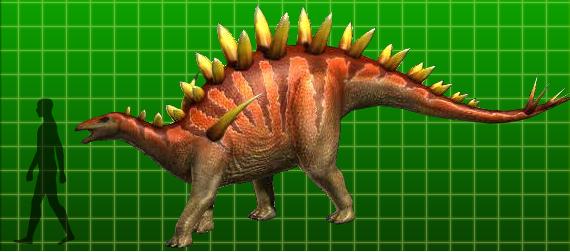














.jpg)



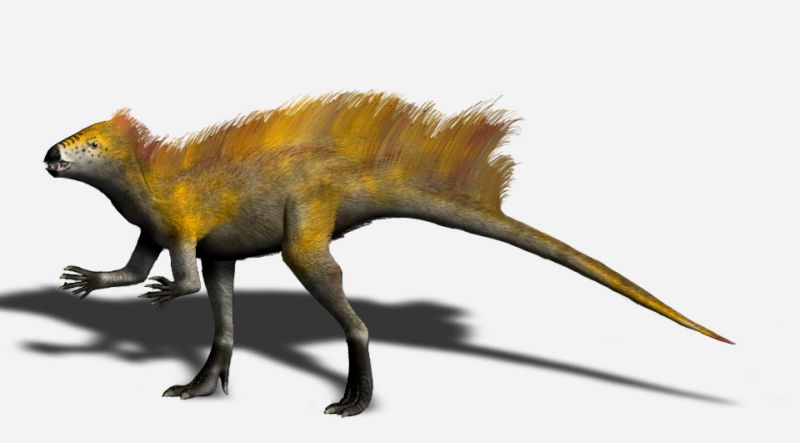

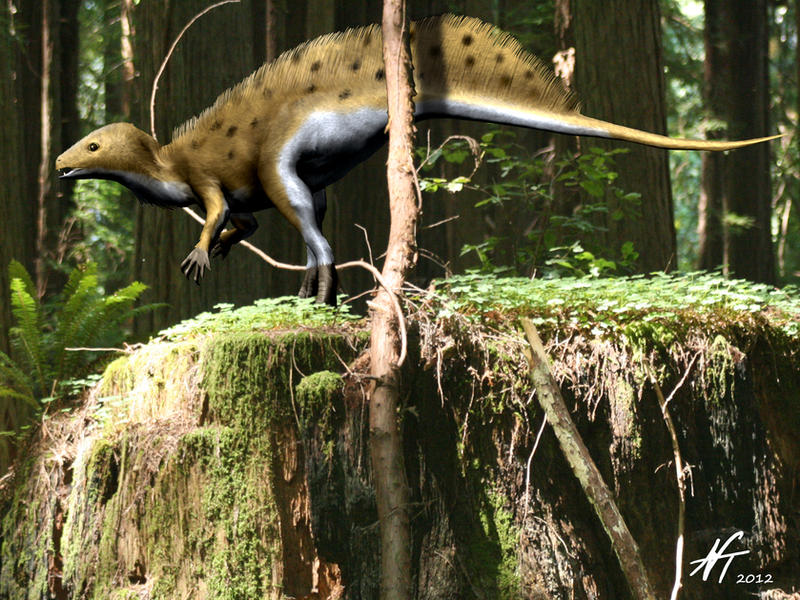
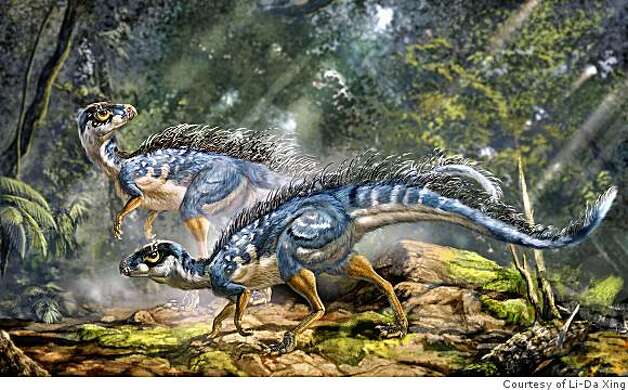
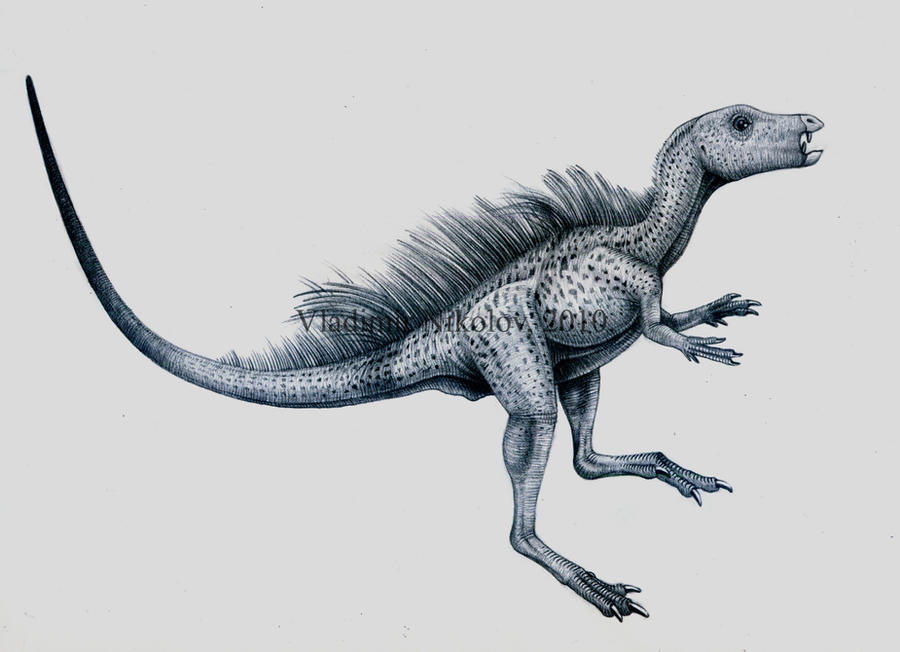







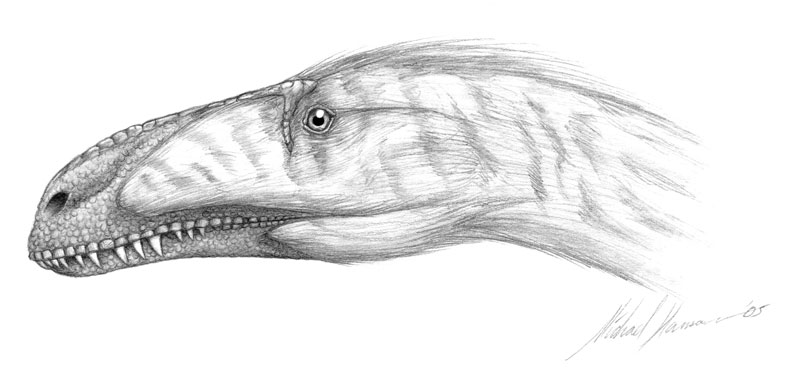





















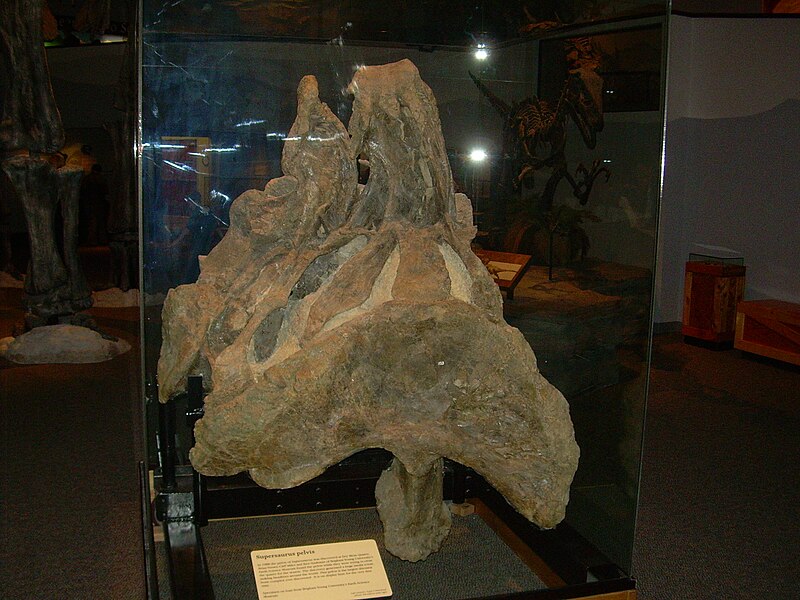




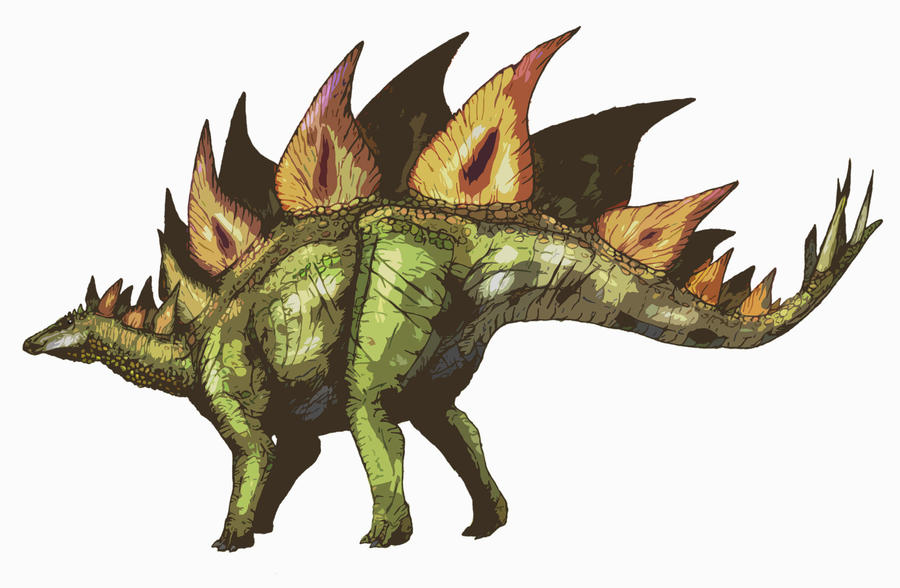

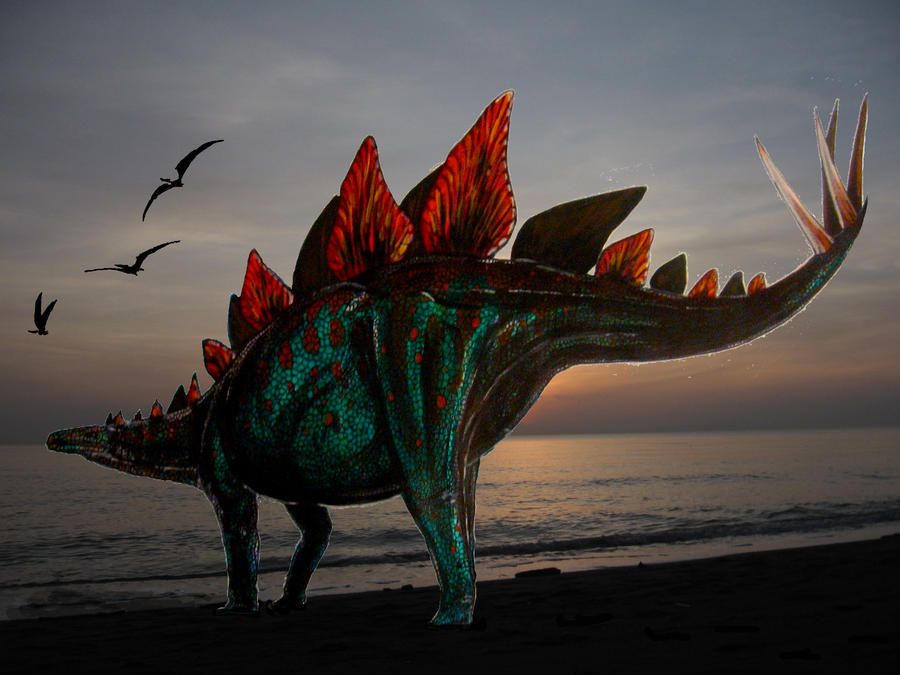






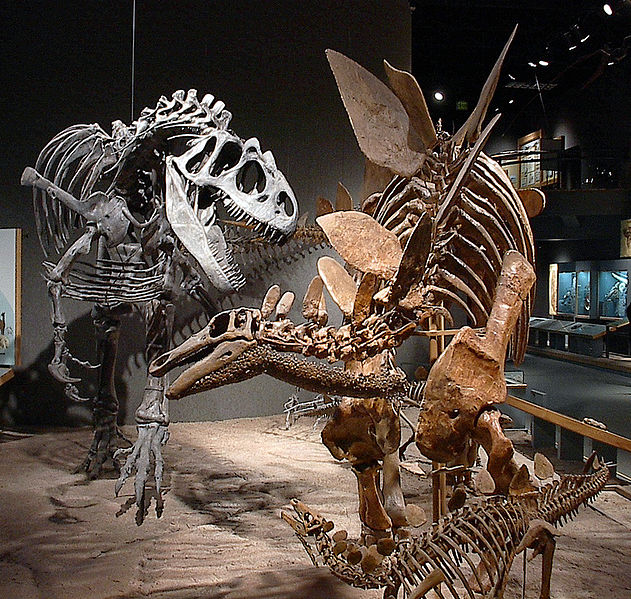

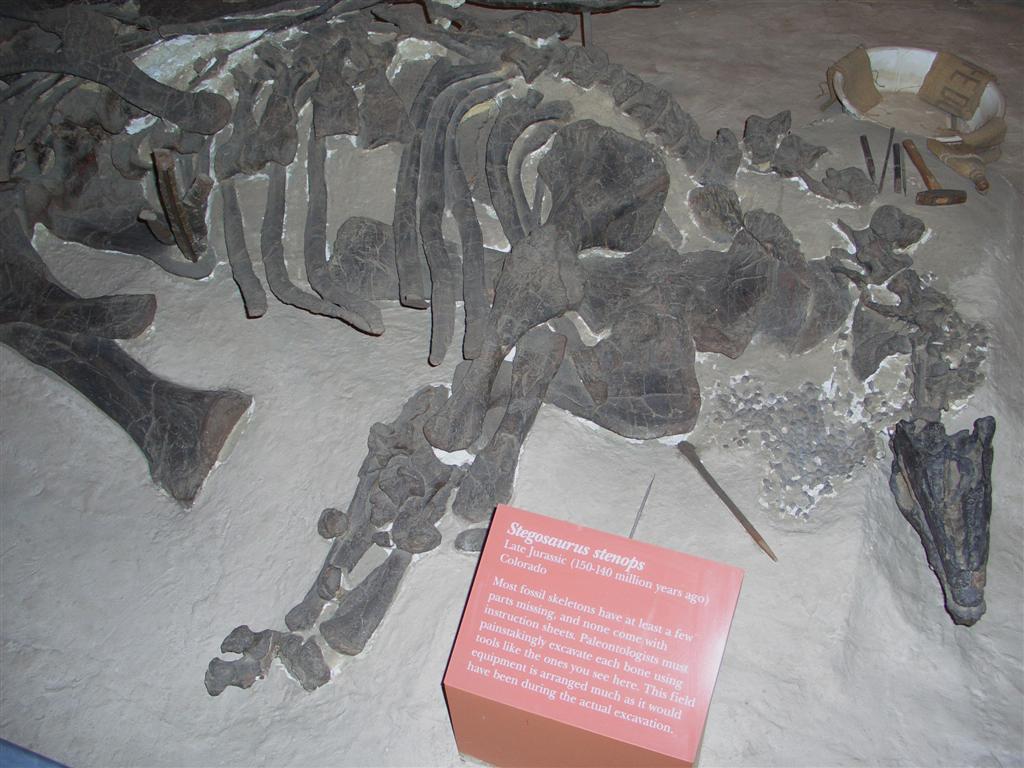













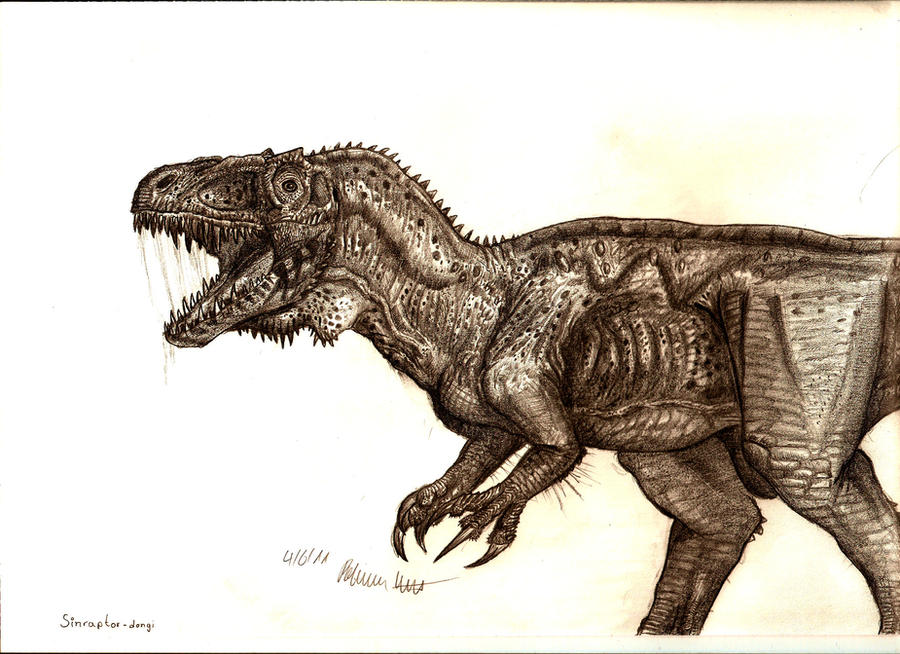














.jpg)







